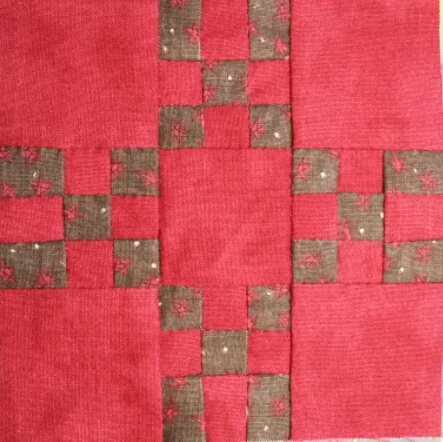Randomness is a word my teenage daughter uses a lot. I’m not 100% convinced it’s a real word (my spellchecker certainly doesn’t think so), but it definitely conveys what I wanted to talk about in this post.
The latest block, pictured above, is fairly similar to the previous block I did – both are nine-patch variations, with the fabric choices designed to emphasize the five squares forming a plus sign. It’s not surprising that the blocks are similar; with 225 distinct blocks in the quilt, there’s bound to be some near repetition.
What is driving me crazy is that they’re situated right next to each other in the quilt – blocks J6 and J7.
This is not the only place in the quilt where this happens (you can check out The Progress page to see what I mean). Blocks B2 and B3 are both circles divided into segments. Blocks I2 and J2 are both diamond in the square variations. Blocks C13, D13, and E13 are all diamond in the square variations too – three similar blocks in a vertical stack. It looks like a traffic light.
I know, all you statisticians out there (who naturally read my quilting blog), are frantically typing in comments about how true randomness means that sometimes these weird coincidences happen. I get that. I just don’t like it.
I’m not a big fan of sampler quilts in general … and yes, I’m aware that you’re all questioning my sanity in taking on the mother of all sampler quilts right about now. You would think samplers would be appealing to me, because every block is different, so I wouldn’t get bored making 20 of the same block. That aspect of samplers is definitely appreciated.
The problem is that sampler quilts are so chaotic. If you’re going to be random, I feel you should go about it in an organized way, and make sure there are no blocks that are right next to very similar-looking blocks.
Instead of clumping together all the blocks with circles in one place, you should spread them out so there’s an equal distribution of circle-based blocks in all sections of the quilt. Then it’s balanced, and I sleep better at night (underneath my super-organized and non-random sampler quilt).
So, while sewing together this block (which took quite a while due to the 41 teeny-tiny pieces in it), I spent a lot of time pondering Jane Stickle’s motivation when putting together the original quilt a century and a half ago. How did she decide what went where?
Did she just stitch up 169 square blocks, and then randomly pick them out of a bag and start sewing them together? Or did she have a plan as to how they would be laid out? The only real trend I see is that most of the easiest blocks are around the edges and most of the difficult blocks are closer to the center.
We’ll probably never know what she was thinking.
For my version, I’m opting to keep the original location of the blocks, but satisfying my need for order the same way that Paulette did: with color. In her original design, Paulette had arranged the fabrics in the quilt to form a Trip Around the World pattern (a series of concentric diamonds). I’ve continued that arrangement, and extended it into the border triangles as well.
Hopefully that will be enough to control the chaos. In the meantime, I’ve got to restore the balance by picking my next block from a different area of the quilt. I’d better make sure to use a different color too. I don’t want to leave anything to random chance.
